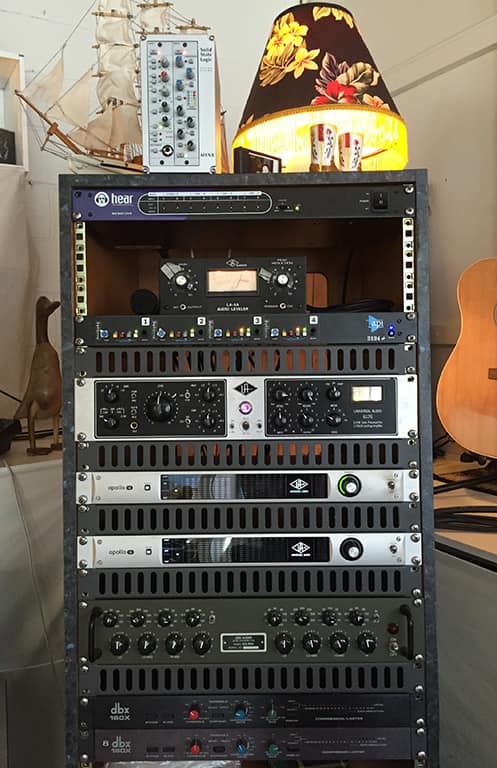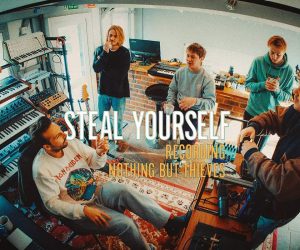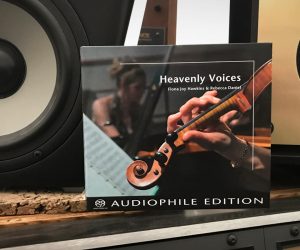
Recording Tips: Tracking Live with Dope Lemon

JAM TOGETHER, THEN CUT TOGETHER
The songs were often the product of a jam session, then cut into a more structured song. Take the single, Uptown Folks. Initially, the band had set up at Inky with a plan to record a different song which didn’t make the record. Then, explained Jordan, “Angus came up with the Uptown Folks line and they just started jamming on the riff while he worked on the lyrics. It turned into a half-hour jam. Then we went back and start cutting it down, finding the melodies, and gluing it together. Then if the lyrics aren’t right because they were done on the spot, we go back in and start overdubbing.” By cutting up the live jams, it keeps the vibe of the performance, with the option to overdub parts where needed.
ALWAYS PUT UP A VOCAL BLEED MIC
Angus is a relatively soft singer — controlled, but soft — which is why Jordan uses a Shure SM7 dynamic mic. Its directionality helps cut down on instruments bleeding into the mic, but doesn’t eradicate it. Inevitably, Angus will overdub at least a few vocal lines, because the lyrics aren’t typically finished during the jam. In order to be able to cut between the live vocal take and overdubs, Jordan puts up an extra mic behind Angus purely to catch the live take spill. If he mutes the live vocal take without adding in the ‘bleed’ mic, the whole tone of the drum kit changes. “I usually put it behind him so I don’t get his vocal on it, just the same noise I can add when I need to,” said Jordan.
CAPTURE THE ROOM WITH A BLUMLEIN PAIR
While Jordan has to figure out creative ways to handle bleed in the vocal mic, other times he’s actively trying to capture it. When he’s tracking a live performance, he spends time ensuring his stereo room mic pair matches the individual panning he’ll use in the mix. Often he’ll use a pair of AKG C414s, sometimes switched to a figure-eight polar pattern and placed centrally in the room. “It doubles your image,” he explained. “Whether the instrument is sitting in front or behind one capsule of the mics, it will be panned to one side.”
He’ll place the stereo room mic “closer to anything acoustic because if amps have to be in the room, I try and get it away from those, same with drums. A lot of the placement is just by sight then walking around the room and hearing where things are sitting. Usually it’s pretty central in the room.
“The reason I do it is to capture the fact they are a band in a room, which can be hard to re-impose on the mix.”
RECORD GUITARS IN CARS
One trick Jordan uses to isolate guitar amps from the live take is to put them in a car boot. “I had one of Angus’s guitar amps in the boot of my Commodore wagon, because they are amazing guitar booths!” he said. “They have a lot of soft surfaces, and hardly any of them are parallel.
“I’ve done a couple of albums with Kasey Chambers, and at one stage Jim Moginie was playing guitar as well as her dad, Bill. We had three wagons lined up as the amp rooms! Then I just put a basic SM57 on those; it’s hard to go past the sound of a 57 on guitar cab.”

COMPRESSING A DRUM SOUND INTO FEW MICS
In the spirit of capturing the band as a whole, Jordan also used minimal spot mics on the drums to keep it sounding like a single instrument. “I try to keep the amount of mics down,” he said. “Usually for a drum kit it’s just two overheads, a kick and a snare; and I don’t always use a snare mic. It’s just about using mic placement, and compression to sort out what’s popping out.”
Jordan mixes primarily in the box, and without a hardware stereo compressor he often compresses his overheads with a stereo version of the 1176 plug-in by UAD. “I usually set a brutally fast release to get everything coming to the front, with the attack set to about half way,” he said. “I don’t really look at the meters to check how many dB of gain reduction I’m sitting at. I just use enough to bring everything into the image without the cymbals getting crazy.
“I use condensers for overheads. I don’t particularly love ribbons on drums, my room is pretty big and the figure-eight pattern of ribbons gets a bit too roomy for me. I find it better to use XY stereo pairs and compress to pull the room sound up. Uptown Folks was just a simple drum setup, with a Blumlein pair for room mics about four metres back.”
COMMIT ALL THE TIME
Commitment was a big part of the Dope Lemon recording process, even to the point of tracking with vocal pedal chains. “The vocal sound on Uptown Folks was from a couple of guitar pedals Angus was running through during the recording stage,” explained Jordan. “It wasn’t a Boss delay, it was a specific sound he was going for. I had no control over that at all. It’s nice to commit to those things because if I had the choice I’d probably get the delay in time and it wouldn’t have the character it does on that tune. It would sound too nice, because it’s second nature to put things in time. It makes the recording really interesting. On the other hand, if you commit to something that kills a song, you haven’t really done your job.”

QUIETLY COMPRESS A LOW LEVEL VOCAL
Jordan treats the vocal very carefully in the mix, because it’s not just the vocal being recorded but the sound of the room too. “I can’t really compress too much because I’m just going to start bringing up drums and guitars,” said Jordan. He generally goes without any when Angus is tracking through his pedals. Which is only possible because he’s a consistent singer. “He’s quiet, but he doesn’t get too dynamic,” explained Jordan. When he does use compression, it’s usually a combination of two plug-ins: “I set up the Fatso with a fast attack and release to control the signal and knock 3dB off the peaks. Then I use an 1176 as a musical compressor to sculpt the tone with a slower attack and release.”
FOCUS ON MIXING, EVEN IN THE BOX
Jordan mixes completely in the box — mostly because of the recall ability — setting all his console faders to zero and using it as a summing box. “It’s taken a while for me to come around to it because of my time at 301, where I was mixing on an SSL,” said Jordan. “I fumbled with it for a while, and kept trying to find smaller studios where I could mix on a console. Initially I migrated through necessity; bands can’t afford to be mixing in big studios. Now I’d rather not mix on consoles and I’m more than happy to do it in the box.”
The mix process was relatively short, compared to the recording process. Jordan mixed the album over seven days, averaging a couple of songs a day. Towards the end of the two years Jordan was “a little restless. You want to hear it released. It took a lot of concentration towards the end because I’d been hearing those songs for so long.
“You need to try to keep it fresh somehow and make sure you’re still listening to the song and not getting over it. Always ask people’s opinions about the mixes. The best part of the album going for that long was how many different feels we have on there. It’s cohesive because I mixed it all, but it’s a really broad collection of emotions.”
I had one of Angus’s guitar amps in the boot of my Commodore wagon, because they are amazing guitar booths!
JAM TOGETHER, THEN CUT TOGETHER
The songs were often the product of a jam session, then cut into a more structured song. Take the single, Uptown Folks. Initially, the band had set up at Inky with a plan to record a different song which didn’t make the record. Then, explained Jordan, “Angus came up with the Uptown Folks line and they just started jamming on the riff while he worked on the lyrics. It turned into a half-hour jam. Then we went back and start cutting it down, finding the melodies, and gluing it together. Then if the lyrics aren’t right because they were done on the spot, we go back in and start overdubbing.” By cutting up the live jams, it keeps the vibe of the performance, with the option to overdub parts where needed.
ALWAYS PUT UP A VOCAL BLEED MIC
Angus is a relatively soft singer — controlled, but soft — which is why Jordan uses a Shure SM7 dynamic mic. Its directionality helps cut down on instruments bleeding into the mic, but doesn’t eradicate it. Inevitably, Angus will overdub at least a few vocal lines, because the lyrics aren’t typically finished during the jam. In order to be able to cut between the live vocal take and overdubs, Jordan puts up an extra mic behind Angus purely to catch the live take spill. If he mutes the live vocal take without adding in the ‘bleed’ mic, the whole tone of the drum kit changes. “I usually put it behind him so I don’t get his vocal on it, just the same noise I can add when I need to,” said Jordan.
CAPTURE THE ROOM WITH A BLUMLEIN PAIR
While Jordan has to figure out creative ways to handle bleed in the vocal mic, other times he’s actively trying to capture it. When he’s tracking a live performance, he spends time ensuring his stereo room mic pair matches the individual panning he’ll use in the mix. Often he’ll use a pair of AKG C414s, sometimes switched to a figure-eight polar pattern and placed centrally in the room. “It doubles your image,” he explained. “Whether the instrument is sitting in front or behind one capsule of the mics, it will be panned to one side.”
He’ll place the stereo room mic “closer to anything acoustic because if amps have to be in the room, I try and get it away from those, same with drums. A lot of the placement is just by sight then walking around the room and hearing where things are sitting. Usually it’s pretty central in the room.
“The reason I do it is to capture the fact they are a band in a room, which can be hard to re-impose on the mix.”
RECORD GUITARS IN CARS
One trick Jordan uses to isolate guitar amps from the live take is to put them in a car boot. “I had one of Angus’s guitar amps in the boot of my Commodore wagon, because they are amazing guitar booths!” he said. “They have a lot of soft surfaces, and hardly any of them are parallel.
“I’ve done a couple of albums with Kasey Chambers, and at one stage Jim Moginie was playing guitar as well as her dad, Bill. We had three wagons lined up as the amp rooms! Then I just put a basic SM57 on those; it’s hard to go past the sound of a 57 on guitar cab.”
COMPRESSING A DRUM SOUND INTO FEW MICS
In the spirit of capturing the band as a whole, Jordan also used minimal spot mics on the drums to keep it sounding like a single instrument. “I try to keep the amount of mics down,” he said. “Usually for a drum kit it’s just two overheads, a kick and a snare; and I don’t always use a snare mic. It’s just about using mic placement, and compression to sort out what’s popping out.”
Jordan mixes primarily in the box, and without a hardware stereo compressor he often compresses his overheads with a stereo version of the 1176 plug-in by UAD. “I usually set a brutally fast release to get everything coming to the front, with the attack set to about half way,” he said. “I don’t really look at the meters to check how many dB of gain reduction I’m sitting at. I just use enough to bring everything into the image without the cymbals getting crazy.
“I use condensers for overheads. I don’t particularly love ribbons on drums, my room is pretty big and the figure-eight pattern of ribbons gets a bit too roomy for me. I find it better to use XY stereo pairs and compress to pull the room sound up. Uptown Folks was just a simple drum setup, with a Blumlein pair for room mics about four metres back.”

COMMIT ALL THE TIME
Commitment was a big part of the Dope Lemon recording process, even to the point of tracking with vocal pedal chains. “The vocal sound on Uptown Folks was from a couple of guitar pedals Angus was running through during the recording stage,” explained Jordan. “It wasn’t a Boss delay, it was a specific sound he was going for. I had no control over that at all. It’s nice to commit to those things because if I had the choice I’d probably get the delay in time and it wouldn’t have the character it does on that tune. It would sound too nice, because it’s second nature to put things in time. It makes the recording really interesting. On the other hand, if you commit to something that kills a song, you haven’t really done your job.”
QUIETLY COMPRESS A LOW LEVEL VOCAL
Jordan treats the vocal very carefully in the mix, because it’s not just the vocal being recorded but the sound of the room too. “I can’t really compress too much because I’m just going to start bringing up drums and guitars,” said Jordan. He generally goes without any when Angus is tracking through his pedals. Which is only possible because he’s a consistent singer. “He’s quiet, but he doesn’t get too dynamic,” explained Jordan. When he does use compression, it’s usually a combination of two plug-ins: “I set up the Fatso with a fast attack and release to control the signal and knock 3dB off the peaks. Then I use an 1176 as a musical compressor to sculpt the tone with a slower attack and release.”
FOCUS ON MIXING, EVEN IN THE BOX
Jordan mixes completely in the box — mostly because of the recall ability — setting all his console faders to zero and using it as a summing box. “It’s taken a while for me to come around to it because of my time at 301, where I was mixing on an SSL,” said Jordan. “I fumbled with it for a while, and kept trying to find smaller studios where I could mix on a console. Initially I migrated through necessity; bands can’t afford to be mixing in big studios. Now I’d rather not mix on consoles and I’m more than happy to do it in the box.”
The mix process was relatively short, compared to the recording process. Jordan mixed the album over seven days, averaging a couple of songs a day. Towards the end of the two years Jordan was “a little restless. You want to hear it released. It took a lot of concentration towards the end because I’d been hearing those songs for so long.
“You need to try to keep it fresh somehow and make sure you’re still listening to the song and not getting over it. Always ask people’s opinions about the mixes. The best part of the album going for that long was how many different feels we have on there. It’s cohesive because I mixed it all, but it’s a really broad collection of emotions.”

















RESPONSES